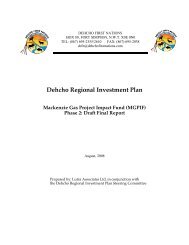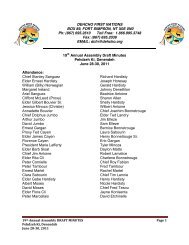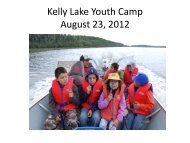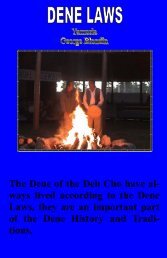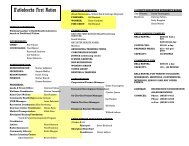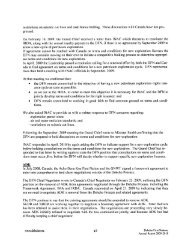NWT 2011-2015 - NWT Species at Risk
NWT 2011-2015 - NWT Species at Risk
NWT 2011-2015 - NWT Species at Risk
Create successful ePaper yourself
Turn your PDF publications into a flip-book with our unique Google optimized e-Paper software.
4. D<strong>at</strong>a Sources and Methods – How did we rank species?<br />
St<strong>at</strong>us Rank C<strong>at</strong>egories<br />
Priorities for Study and Management<br />
Each species was placed into one of ten standard rank c<strong>at</strong>egories:<br />
1) At <strong>Risk</strong> = species for which a detailed assessment has<br />
already been completed (e.g., by COSEWIC or jurisdictional<br />
st<strong>at</strong>us reports) th<strong>at</strong> determined the species to be <strong>at</strong> risk of<br />
extirp<strong>at</strong>ion or extinction. This is a special c<strong>at</strong>egory used<br />
only for species th<strong>at</strong> have been assessed as “Endangered”<br />
or “Thre<strong>at</strong>ened” according to COSEWIC, or according to<br />
SARC in the <strong>NWT</strong>.<br />
C<strong>at</strong>egories determined<br />
using the scoring m<strong>at</strong>rix<br />
2) May Be At <strong>Risk</strong> = species th<strong>at</strong> may be <strong>at</strong> risk of extinction<br />
or extirp<strong>at</strong>ion, and are therefore candid<strong>at</strong>es for detailed risk<br />
assessment. This is the highest rank th<strong>at</strong> can be given to a<br />
species using the General St<strong>at</strong>us Ranking system independent<br />
of a more detailed assessment as noted in the At <strong>Risk</strong> c<strong>at</strong>egory.<br />
These species are ranked with the highest priority<br />
for a more detailed assessment by COSEWIC in Canada<br />
or SARC in the <strong>NWT</strong>.<br />
3) Sensitive = species th<strong>at</strong> are not <strong>at</strong> risk of extinction<br />
or extirp<strong>at</strong>ion but may require special <strong>at</strong>tention or protection<br />
to prevent them from becoming <strong>at</strong> risk.<br />
These species are ranked with a medium priority for<br />
a detailed assessment.<br />
4) Secure = species th<strong>at</strong> are not <strong>at</strong> risk or sensitive.<br />
These species have the lowest priority for a detailed<br />
assessment.<br />
The evalu<strong>at</strong>ion process was similar for each group of<br />
species. The scoring process was performed with the help<br />
of several experts and knowledgeable persons listed in the<br />
acknowledgement section <strong>at</strong> the end of the report. More<br />
inform<strong>at</strong>ion on guidelines and processes can be found in<br />
Carrière and Lange (2002).<br />
C<strong>at</strong>egories determined<br />
using its definition only<br />
5) Undetermined = species for which insufficient inform<strong>at</strong>ion,<br />
knowledge, or d<strong>at</strong>a is available to reliably evalu<strong>at</strong>e their<br />
general st<strong>at</strong>us.<br />
6) Not Assessed = species which have not been examined for this<br />
report. Due to time constraints, some species have not been<br />
assessed for the present report. This inform<strong>at</strong>ion provides a list<br />
of species th<strong>at</strong> should be examined soon.<br />
7) Alien = species th<strong>at</strong> have been introduced as a result of human<br />
activities. Most alien species have been introduced to North<br />
America from Europe and Asia. Changes in the number of alien<br />
species can be monitored as their presence and abundance may<br />
affect the st<strong>at</strong>us of wild species n<strong>at</strong>ive to the <strong>NWT</strong>. Synonymous<br />
with exotic or introduced.<br />
8) Extirp<strong>at</strong>ed/Extinct = species no longer thought to be present<br />
in the <strong>NWT</strong> (extirp<strong>at</strong>ed) or are believed no longer present<br />
anywhere in the world (extinct).<br />
9) Vagrant = species occurring infrequently and unpredictably<br />
in the <strong>NWT</strong>. These species are outside their usual range.<br />
Synonymous with accidental.These species may be in the<br />
<strong>NWT</strong> due to unusual we<strong>at</strong>her occurrences, an accident<br />
during migr<strong>at</strong>ion, or unusual behaviour by a small number of<br />
individuals. If a species appears in the <strong>NWT</strong> with increasing<br />
predictability and more frequently, it may eventually be given<br />
a different rank. Changes in the number of vagrant species may<br />
be a good indic<strong>at</strong>or of general ecosystem or clim<strong>at</strong>ic change.<br />
10)Presence Expected = species not yet recorded in the <strong>NWT</strong>,<br />
but are expected to be present. These species are expected<br />
in the <strong>NWT</strong> due to their presence in adjacent jurisdiction(s),<br />
the presence of appropri<strong>at</strong>e habit<strong>at</strong> in the <strong>NWT</strong>, and other<br />
evidence. The st<strong>at</strong>us rank is used to list species for which we<br />
need firm evidence of their presence in the <strong>NWT</strong>. They form<br />
a “Look For” species list. When a new species is found in<br />
the <strong>NWT</strong>, the list of “Presence Expected” species is useful to<br />
differenti<strong>at</strong>e between species th<strong>at</strong> may have been in the <strong>NWT</strong><br />
all along but simply had not been confirmed, and species th<strong>at</strong><br />
are truly new to <strong>NWT</strong> and may indic<strong>at</strong>e th<strong>at</strong> ecosystems are<br />
changing. This is a new rank c<strong>at</strong>egory developed in 2005 for<br />
the <strong>NWT</strong>; no other jurisdictions in Canada have adopted it yet.<br />
10<br />
<strong>NWT</strong> <strong>Species</strong> <strong>2011</strong>-<strong>2015</strong>



